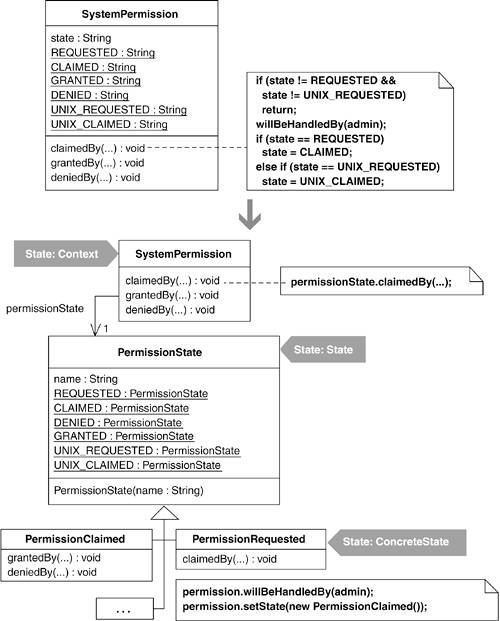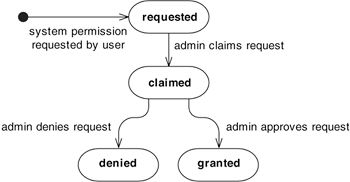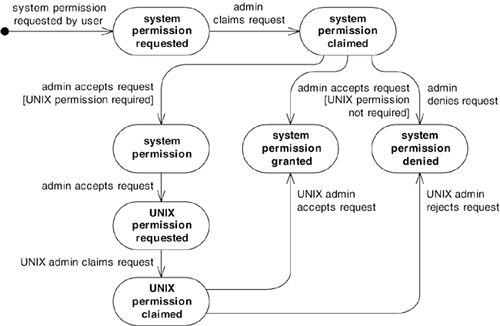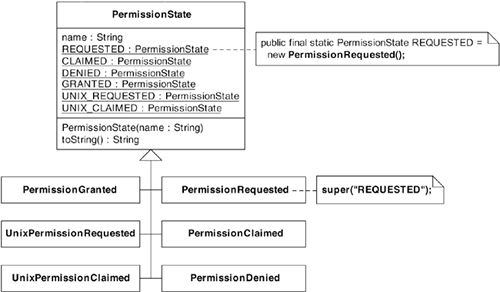Replace State-Altering Conditionals with State The conditional expressions that control an object's state transitions are complex.
Replace the conditionals with State classes that handle specific states and transitions between them.
 Motivation The primary reason for refactoring to the State pattern [DP] is to tame overly complex state-altering conditional logic. Such logic, which tends to spread itself throughout a class, controls an object's state, including how states transition to other states. When you implement the State pattern, you create classes that represent specific states of an object and the transitions between those states. The object that has its state changed is known in Design Patterns [DP] as the context. A context delegates state-dependent behavior to a state object. State objects make state transitions at runtime by making the context point to a different state object. Moving state-altering conditional logic out of one class and into a family of classes that represent different states can yield a simpler design that provides a better bird's-eye view of the transitions between states. On the other hand, if you can easily understand the state transition logic in a class, you likely don't need to refactor to the State pattern (unless you plan to add many more state transitions in the future). The Example section for this refactoring shows a case where state-altering conditional logic is no longer easy to follow or extend and where the State pattern can make a real difference. Before refactoring to State, it's always a good idea to see if simpler refactorings, such as Extract Method [F], can help clean up the state-changing conditional logic. If they can't, refactoring to State can help remove or reduce many lines of conditional logic, yielding simpler code that's easier to understand and extend. This Replace State-Altering Conditionals with State refactoring is different from Martin Fowler's Replace Type Code with State/Strategy [F] for the following reasons. -
Differences between State and Strategy: The State pattern is useful for a class that must easily transition between instances of a family of state classes, while the Strategy pattern is useful for allowing a class to delegate execution of an algorithm to an instance of a family of Strategy classes. Because of these differences, the motivation and mechanics for refactoring to these two patterns differs (see Replace Conditional Logic with Strategy, 129). -
End-to-end mechanics: Martin deliberately doesn't document a full refactoring to the State pattern because the complete implementation depends on a further refactoring he wrote, Replace Conditional with Polymorphism [F]. While I respect that decision, I thought it would be more helpful to readers to understand how the refactoring works from end to end, so my Mechanics and Example sections delineate all of the steps to get you from conditional state-changing logic to a State implementation. If your state objects have no instance variables (i.e., they are stateless), you can optimize memory usage by having context objects share instances of the stateless state instances. The Flyweight and Singleton patterns [DP] are often used to implement sharing (e.g., see Limit Instantiation with Singleton, 296). However, it's always best to add state-sharing code after your users experience system delays and a profiler points you to the state-instantiation code as a prime bottleneck. Benefits and Liabilities | + | Reduces or removes state-changing conditional logic. | | + | Simplifies complex state-changing logic. | | + | Provides a good bird's-eye view of state-changing logic. | | – | Complicates a design when state transition logic is already easy to follow. |
|
Mechanics -
The context class is a class that contains the original state field, a field that gets assigned to or compared against a family of constants during state transitions. Apply Replace Type Code with Class (286) on the original state field such that its type becomes a class. We'll call that new class the state superclass. The context class is known as State: Context and the state superclass as State: State in Design Patterns [DP]. -
Each constant in the state superclass now refers to an instance of the state superclass. Apply Extract Subclass [F] to produce one subclass (known as State: ConcreteState [DP]) per constant, then update the constants in the state superclass so that each refers to the correct subclass instance of the state superclass. Finally, declare the state superclass to be abstract. -
Find a context class method that changes the value of the original state field based on state transition logic. Copy this method to the state superclass, making the simplest changes possible to make the new method work. (A common, simple change is to pass the context class to the method in order to have code call methods on the context class.) Finally, replace the body of the context class method with a delegation call to the new method. Repeat this step for every context class method that changes the value of the original state field based on state transition logic. -
Choose a state that the context class can enter, and identify which state superclass methods make this state transition to other states. Copy the identified method(s), if any, to the subclass associated with the chosen state and remove all unrelated logic. Unrelated logic usually includes verifications of a current state or logic that transitions to unrelated states. Repeat for all states the context class can enter. -
Delete the bodies of each of the methods copied to the state superclass during step 3 to produce an empty implementation for each method. Example To understand when it makes sense to refactor to the State pattern, it helps to study a class that manages its state without requiring the sophistication of the State pattern. SystemPermission is such a class. It uses simple conditional logic to keep track of the state of a permission request to access a software system. Over the lifetime of a SystemPermission object, an instance variable named state transitions between the states requested, claimed, denied, and granted. Here is a state diagram of the possible transitions:  Below is the code for SystemPermission and a fragment of test code to show how the class gets used: public class SystemPermission... private SystemProfile profile; private SystemUser requestor; private SystemAdmin admin; private boolean isGranted; private String state; public final static String REQUESTED = "REQUESTED"; public final static String CLAIMED = "CLAIMED"; public final static String GRANTED = "GRANTED"; public final static String DENIED = "DENIED"; public SystemPermission(SystemUser requestor, SystemProfile profile) { this.requestor = requestor; this.profile = profile; state = REQUESTED; isGranted = false; notifyAdminOfPermissionRequest(); } public void claimedBy(SystemAdmin admin) { if (!state.equals(REQUESTED)) return; willBeHandledBy(admin); state = CLAIMED; } public void deniedBy(SystemAdmin admin) { if (!state.equals(CLAIMED)) return; if (!this.admin.equals(admin)) return; isGranted = false; state = DENIED; notifyUserOfPermissionRequestResult(); } public void grantedBy(SystemAdmin admin) { if (!state.equals(CLAIMED)) return; if (!this.admin.equals(admin)) return; state = GRANTED; isGranted = true; notifyUserOfPermissionRequestResult(); } public class TestStates extends TestCase... private SystemPermission permission; public void setUp() { permission = new SystemPermission(user, profile); } public void testGrantedBy() { permission.grantedBy(admin); assertEquals("requested", permission.REQUESTED, permission.state()); assertEquals("not granted", false, permission.isGranted()); permission.claimedBy(admin); permission.grantedBy(admin); assertEquals("granted", permission.GRANTED, permission.state()); assertEquals("granted", true, permission.isGranted()); }
Notice how the instance variable, state, gets assigned to different values as clients call specific SystemPermission methods. Now look at the overall conditional logic in SystemPermission. This logic is responsible for transitioning between states, but the logic isn't very complicated so the code doesn't require the sophistication of the State pattern. This conditional state-changing logic can quickly become hard to follow as more real-world behavior gets added to the SystemPermission class. For example, I helped design a security system in which users needed to obtain UNIX and/or database permissions before the user could be granted general permission to access a given software system. The state transition logic that requires UNIX permission before general permission may be granted looks like this: 
Adding support for UNIX permission makes SystemPermission's state-altering conditional logic more complicated than it used to be. Consider the following: public class SystemPermission... public void claimedBy(SystemAdmin admin) { if (!state.equals(REQUESTED) && !state.equals(UNIX_REQUESTED)) return; willBeHandledBy(admin); if (state.equals(REQUESTED)) state = CLAIMED; else if (state.equals(UNIX_REQUESTED)) state = UNIX_CLAIMED; } public void deniedBy(SystemAdmin admin) { if (!state.equals(CLAIMED) && !state.equals(UNIX_CLAIMED)) return; if (!this.admin.equals(admin)) return; isGranted = false; isUnixPermissionGranted = false; state = DENIED; notifyUserOfPermissionRequestResult(); } public void grantedBy(SystemAdmin admin) { if (!state.equals(CLAIMED) && !state.equals(UNIX_CLAIMED)) return; if (!this.admin.equals(admin)) return; if (profile.isUnixPermissionRequired() && state.equals(UNIX_CLAIMED)) isUnixPermissionGranted = true; else if (profile.isUnixPermissionRequired() && !isUnixPermissionGranted()) { state = UNIX_REQUESTED; notifyUnixAdminsOfPermissionRequest(); return; } state = GRANTED; isGranted = true; notifyUserOfPermissionRequestResult(); }
An attempt can be made to simplify this code by applying Extract Method [F]. For example, I could refactor the grantedBy() method like so: public void grantedBy(SystemAdmin admin) { if ( !isInClaimedState()) return; if (!this.admin.equals(admin)) return; if ( isUnixPermissionRequestedAndClaimed()) isUnixPermissionGranted = true; else if ( isUnixPermisionDesiredButNotRequested()) { state = UNIX_REQUESTED; notifyUnixAdminsOfPermissionRequest(); return; } ...
Although that's an improvement, SystemPermission now has lots of state-specific Boolean logic (e.g., methods like isUnixPermissionRequestedAndClaimed()), and the grantedBy() method still isn't simple. It's time to see how I simplify things by refactoring to the State pattern. -
SystemPermission has a field called state, which is of type String. The first step is to change state's type to be a class by applying the refactoring Replace Type Code with Class (286). This yields the following new class: public class PermissionState { private String name; private PermissionState(String name) { this.name = name; } public final static PermissionState REQUESTED = new PermissionState("REQUESTED"); public final static PermissionState CLAIMED = new PermissionState("CLAIMED"); public final static PermissionState GRANTED = new PermissionState("GRANTED"); public final static PermissionState DENIED = new PermissionState("DENIED"); public final static PermissionState UNIX_REQUESTED = new PermissionState("UNIX_REQUESTED"); public final static PermissionState UNIX_CLAIMED = new PermissionState("UNIX_CLAIMED"); public String toString() { return name; } }
The refactoring also replaces SystemPermission's state field with one called permissionState, which is of type PermissionState: public class SystemPermission... private PermissionState permissionState; public SystemPermission(SystemUser requestor, SystemProfile profile) { ... setPermission(PermissionState.REQUESTED); ... } public PermissionState getState() { return permissionState; } private void setState(PermissionState state) { permissionState = state; } public void claimedBy(SystemAdmin admin) { if (!getState().equals(PermissionState.REQUESTED) && !getState().equals(PermissionState.UNIX_REQUESTED)) return; ... } etc...
-
PermissionState now contains six constants, all of which are instances of PermissionState. To make each of these constants an instance of a subclass of PermissionState, I apply Extract Subclass [F] six times to produce the result shown in the following diagram. 
Because no client will ever need to instantiate PermissionState, I declare it to be abstract: public abstract class PermissionState...
The compiler is happy with all of the new code, so I press on. -
Next, I find a method on SystemPermission that changes the value of permission based on state transition logic. There are three such methods in SystemPermission: claimedBy(), deniedBy(), and grantedBy(). I start by working with claimedBy(). I must copy this method to PermissionState, making enough changes to get it to compile and then replacing the body of the original claimedBy() method with a call to the new PermissionState version: public class SystemPermission... private void setState(PermissionState state) { // now has package-level visibility permissionState = state; } public void claimedBy(SystemAdmin admin) { state.claimedBy(admin, this); } void willBeHandledBy(SystemAdmin admin) { this.admin = admin; } abstract class PermissionState... public void claimedBy(SystemAdmin admin, SystemPermission permission) { if (!permission.getState().equals(REQUESTED) && !permission.getState().equals(UNIX_REQUESTED)) return; permission.willBeHandledBy(admin); if (permission.getState().equals(REQUESTED)) permission.setState(CLAIMED); else if (permission.getState().equals(UNIX_REQUESTED)) { permission.setState(UNIX_CLAIMED); } }
After I compile and test to see that the changes worked, I repeat this step for deniedBy() and grantedBy(). -
Now I choose a state that SystemPermission can enter and identify which PermissionState methods make this state transition to other states. I'll start with the REQUESTED state. This state can only transition to the CLAIMED state, and the transition happens in the PermissionState.claimedBy() method. I copy that method to the PermissionRequested class: class PermissionRequested extends PermissionState... public void claimedBy(SystemAdmin admin, SystemPermission permission) { if (!permission.getState().equals(REQUESTED) && !permission.getState().equals(UNIX_REQUESTED)) return; permission.willBeHandledBy(admin); if (permission.getState().equals(REQUESTED)) permission.setState(CLAIMED); else if (permission.getState().equals(UNIX_REQUESTED)) { permission.setState(UNIX_CLAIMED); } } }
A lot of logic in this method is no longer needed. For example, anything related to the UNIX_REQUESTED state isn't needed because we're only concerned with the REQUESTED state in the PermissionRequested class. We also don't need to check whether our current state is REQUESTED because the fact that we're in the PermissionRequested class tells us that. So I can reduce this code to the following: class PermissionRequested extends Permission... public void claimedBy(SystemAdmin admin, SystemPermission permission) { permission.willBeHandledBy(admin); permission.setState(CLAIMED); } }
As always, I compile and test to make sure I didn't break anything. Now I repeat this step for the other five states. Let's look at what is required to produce the PermissionClaimed and PermissionGranted states. The CLAIMED state can transition to DENIED, GRANTED, or UNIX REQUESTED. The deniedBy() or grantedBy() methods take care of these transitions, so I copy those methods to the PermissionClaimed class and delete unnecessary logic: class PermissionClaimed extends PermissionState... public void deniedBy(SystemAdmin admin, SystemPermission permission) { if (!permission.getState().equals(CLAIMED) && !permission.getState().equals(UNIX_CLAIMED)) return; if (!permission.getAdmin().equals(admin)) return; permission.setIsGranted(false); permission.setIsUnixPermissionGranted(false); permission.setState(DENIED); permission.notifyUserOfPermissionRequestResult(); } public void grantedBy(SystemAdmin admin, SystemPermission permission) { if (!permission.getState().equals(CLAIMED) && ! permission.getState().equals(UNIX_CLAIMED)) return; if (!permission.getAdmin().equals(admin)) return; if (permission.getProfile().isUnixPermissionRequired() && permission.getState().equals(UNIX_CLAIMED)) permission.setIsUnixPermissionGranted(true); elseif (permission.getProfile().isUnixPermissionRequired() && !permission.isUnixPermissionGranted()) { permission.setState(UNIX_REQUESTED); permission.notifyUnixAdminsOfPermissionRequest(); return; } permission.setState(GRANTED); permission.setIsGranted(true); permission.notifyUserOfPermissionRequestResult(); }
For PermissionGranted, my job is easy. Once a SystemPermission reaches the GRANTED state, it has no further states it can transition to (i.e., it's at an end state). So this class doesn't need to implement any transition methods (e.g., claimedBy()). In fact, it really needs to inherit empty implementations of the transition methods, which is exactly what will happen after the next step in the refactoring. -
In PermissionState, I can now delete the bodies of claimedBy(), deniedBy(), and grantedBy(), leaving the following: abstract class PermissionState { public String toString(); public void claimedBy(SystemAdmin admin, SystemPermission permission) {} public void deniedBy(SystemAdmin admin, SystemPermission permission) {} public void grantedBy(SystemAdmin admin, SystemPermission permission) {} }
I compile and test to confirm that the states continue to behave correctly. They do. The only remaining question is how best to celebrate this successful refactoring to the State pattern. |